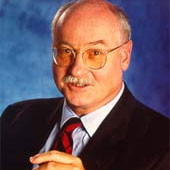The End of Economics — As We Knew It?
Can the world afford to be optimistic about an early recovery of the global economy?
September 3, 2003
Most observers currently assume that the current increase in GDP growth rates is a sustainable development, which — if anything — will tend to accelerate in the course of 2004.
Forecasts call for over 3% growth in the United States in 2004 (and some say over 4%), 2% in Europe — and just under 2% in Germany.
Basically, future economic growth depends on whether the current upward trend triggers multiplier and acceleration effects — as it should, according to theoretical models.
Based on the traditional cyclical models, the current upswing is supposed to trigger more investment and more consumption — and thus more income. This will then lead to a self-sustaining upswing over a period of what might be several years.
This is what the U.S. Federal Reserve assumes in its models. If it does not happen that way, however, the upturn will fizzle out as soon as the factors which triggered it in the first place are no longer operative. I doubt that traditional models work any longer as we were taught they would.
In the second quarter, some 80% of growth in the United States was due to rising government expenditure (particularly in the defense area) and lower taxes.
At the same time, the budget shortfall is by now so oversized ($450 billion) that it can’t get much bigger. Fiscal policy next year will thus have to stop pump-priming relatively abruptly — no matter what the economy is doing.
It will put the brakes on the economy — instead of fueling it (hence producing negative multiplier effects).
As a result, investment is only being made in replacing equipment — not in expansion. Private households are also showing signs of satiation, and this further dampens demand.
They are a burden, especially for U.S. consumers who had profited from the constant refinancing of their mortgages. In the traditional models, interest rates would only rise much later in the growth cycle, when there are real scarcities on the capital markets.
These also have an effect on companies as a result of cuts in subsidies (especially in Germany, but in other European countries as well).
After all, it’s not as if the government’s pursuit of reform policies takes the strain off the private sector as a whole. Rather, the financial burdens are just shifted around. And on top of this, prices of public services are being increased.
Although stock prices have enjoyed a respectable recovery since March 2003, the German stock index, for example, is still some 40% below the average for the year 2001 — and some 15% below that of the year 2002. This limits opportunities for investments. A number of companies must raise fresh capital.
This means that, even when demand rises, no additional workers are employed. Instead, the number of unemployed stays high as productivity rises. Thus an important component of Keynes’ multiplier theory is missing.
These pose great risks, especially for the export sector — and thus dampen the potential for growth.
In the spring of 2003, for example, this discrepancy led to a rapid collapse of the incipient upswing. With the economy, it’s like in real life — when expectations diverge too far from reality, disappointments are bound to occur.
With these arguments, I do not aim to diminish — or belittle — the upturn. Certainly, we have a couple of good months ahead of us. And no relapse into recession is lurking thereafter.
Nevertheless, we should not base long-term considerations on exaggerated growth expectations. The acid test of the economy is to find out whether or not multiplier and acceleration processes really take effect.
We will find out for sure in the course of 2004 — when budget deficits in the United States stop growing and are reduced in Europe.
We will also have to await what will happen when the excitement over successful reforms in Germany and elsewhere in Europe wanes — and realism sets in.
When one looks at the financial markets, the optimism of many analysts seems well-founded in terms of overall economic performance.
However, since markets usually anticipate the economic trend by some six months, the real economic situation could turn more critical — and less rosy — around the turn of the year.
Read previous
Will You Still Love Us Tomorrow?
September 2, 2003
